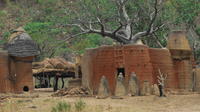3 Day Tour to Koutammakou - The Land of the Batammariba from Lome
Lome, Togo
Trip Type: Multi-day Tours
Duration: 3 days
The Koutammakou, the Land of the Batammariba (=Tamberma) that live in fortified dwellings. Similar in form to medieval castles, they are one of the most beautiful examples of ancient African architecture. Their style impressed Le Corbusier, who talked about sculptural architecture. In fact the houses are built with hands, layer by layer, putting round balls of mud and shaping them following the design of the house.
Visits to Kabye mountains and meeting with traditional blacksmiths. Very interesting: they are using still today stones instead of harmer;
Visits to Kabye mountains and meeting with traditional blacksmiths. Very interesting: they are using still today stones instead of harmer;
More About This Activity All Multi-day Tours →
The Koutammakou, the Land of the Batammariba (=Tamberma) that live in fortified dwellings. Similar in form to medieval castles, they are one of the most beautiful examples of ancient African architecture. Their style impressed Le Corbusier, who talked about sculptural architecture. In fact the houses are built with hands, layer by layer, putting round balls of mud and shaping them following the design of the house.
Visits to Kabye mountains and meeting with traditional blacksmiths. Very interesting: they are using still today stones instead of harmer;Day.1 : Lome – Kara
transfer to the north and stop to visits villages.
Overnight in Hotel, self-contained rooms with private bathroom
Day. 2 : Kara – Tamberma – Kara
The Koutammakou, the Land of the Batammariba (=Tamberma) that live in fortified dwellings. Similar in form to medieval castles, they are one of the most beautiful examples of ancient African architecture. Their style impressed Le Corbusier, who talked about « sculptural architecture ». In fact the houses are build with hands, layer by layer, putting round balls of mud and shaping them following the design of the house. A kind of sensual gesture, mixing strength, care and esthetic.
Their strong tradition beliefs are proved the presence of big shrines, of a phallic form, at the entrance of their homes. With the permission granted us by the inhabitants we will enter their homes so we can better understand their way of life. Actually their houses are a projection of their anthropology and cosmology: the first ground, with its darkness, represents the death: it is the place of the ancestors; the second floor, open to the sky, represents the life: it is the place where the grand mum keeps the babies as long as she has found which ancestor has come back in the new life.
All the family, the food and the animals are kept in the house, for the survival of the family group in case of attack of enemies. For centuries these populations have been seeking refuge in the hard to access Atakora mountain chain to escape from slave trade practiced by Northern Muslim African merchants.
Overnight in Hotel, self-contained rooms with private bathroom
Day. 3: Kara – Lome
Before leaving, visits to Kabye mountains and meeting with traditional blacksmiths
Their house are called « Soukala ». It’s a group of huts joined together with a wall. Within each house lives only one patriarchal family.
Very interesting: blacksmiths using still today stones instead of harmer;
Women making traditional pottery and old style floors made up with pieces of potteries.
Drive down to Lome
Including:
• Guide
• Car, fuel and driver
• Local guides (Tamberma and Kabye visits)
• Fees in Tamberma valley
• Accommodations in bed and breakfast
Visits to Kabye mountains and meeting with traditional blacksmiths. Very interesting: they are using still today stones instead of harmer;Day.1 : Lome – Kara
transfer to the north and stop to visits villages.
Overnight in Hotel, self-contained rooms with private bathroom
Day. 2 : Kara – Tamberma – Kara
The Koutammakou, the Land of the Batammariba (=Tamberma) that live in fortified dwellings. Similar in form to medieval castles, they are one of the most beautiful examples of ancient African architecture. Their style impressed Le Corbusier, who talked about « sculptural architecture ». In fact the houses are build with hands, layer by layer, putting round balls of mud and shaping them following the design of the house. A kind of sensual gesture, mixing strength, care and esthetic.
Their strong tradition beliefs are proved the presence of big shrines, of a phallic form, at the entrance of their homes. With the permission granted us by the inhabitants we will enter their homes so we can better understand their way of life. Actually their houses are a projection of their anthropology and cosmology: the first ground, with its darkness, represents the death: it is the place of the ancestors; the second floor, open to the sky, represents the life: it is the place where the grand mum keeps the babies as long as she has found which ancestor has come back in the new life.
All the family, the food and the animals are kept in the house, for the survival of the family group in case of attack of enemies. For centuries these populations have been seeking refuge in the hard to access Atakora mountain chain to escape from slave trade practiced by Northern Muslim African merchants.
Overnight in Hotel, self-contained rooms with private bathroom
Day. 3: Kara – Lome
Before leaving, visits to Kabye mountains and meeting with traditional blacksmiths
Their house are called « Soukala ». It’s a group of huts joined together with a wall. Within each house lives only one patriarchal family.
Very interesting: blacksmiths using still today stones instead of harmer;
Women making traditional pottery and old style floors made up with pieces of potteries.
Drive down to Lome
Including:
• Guide
• Car, fuel and driver
• Local guides (Tamberma and Kabye visits)
• Fees in Tamberma valley
• Accommodations in bed and breakfast
« Go Back

